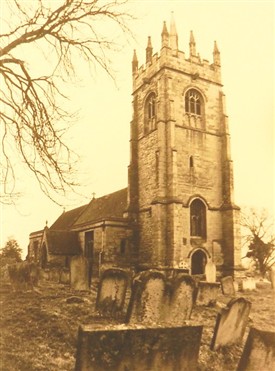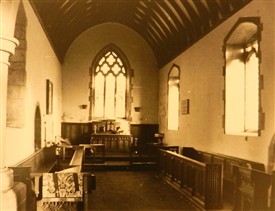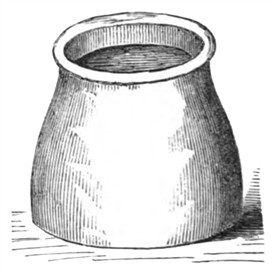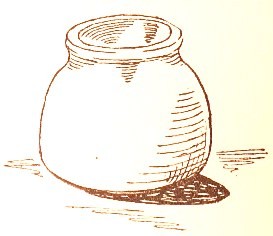Sound Advice from Upton

Upton Church today
Reg Baker

The chancel at Upton Church as it is today
Reg Baker

A drawing of one of the 6 urns - or 'Sound Jars' - found in the walls at Upton church
From The Gentlemen's Magazine, 1863

An alternative rendering of one of the Upton 'sound jars'.
When historic sound enhancers were found at Upton Church
When the chancel of Upton church was rebuilt in 1863, six rough earthenware pots were found embedded in the walls of the old structure.
The pots were placed three on each side at intervals of about 6ft, and about 7ft above the ground. The mouths of the pots faced outwards, and were covered in plaster making them invisible prior to the demolition of the chancel. One such urn was, however, preserved intact by the incumbent. Each urn was pale red and 9.5 inches high. Circumference at the base was 36inches, and 26 inches at the neck.
They made the singing better and resound more
Strange though the circumstance may be, as soon as they were unearthed at Upton the purpose of the urns was quickly identified. They were intended as a system for sound enhancement within the church - to increase volume or improve the acoustic resonance of singing and chanting. In pre-microphone and amplifier days it was a well-known method of sound enhancement for large buildings, having antecedents as far back as ancient Greece and Rome.
The whole matter was discussed in the Gentleman's Magazine at the time of the Upton discovery (Vol.215, December 1863, pp.750-753) and may be read in full HERE Some of the key points raised are quoted below:-
"A human voice of ordinary power, clear tone, and moderate pitch, can fill only a certain number of cubic feet of enclosed space. This fact the ancients were fully acquainted with; and when compelled to increase the size of their public halls, theatres, &c., beyond the ordinary hearing capacity, they endeavoured to compensate for the increased size of the building by various contrivances.....
"The ancients in their theatres used vases of clay or bronze, of peculiar forms, and which were placed under the seats, in one, two, or three rows, according to the size of their building. Vitruvius says:—
"It may be said that many theatres are built yearly at Rome, in none of which are these contrivances used, but all public theatres have many boarded surfaces, which resound by nature. We may observe this from singers, who when they wish to raise a loud note turn to the doors of the scene, and thus receive p751a help for their voice. But when the theatres are built of solid materials, as stone or marble, which are not sonorous, then these methods are to be employed. If it is asked in what theatre they are made use of, we have none at Rome;b but in different parts of Italy, and in the Greek provinces, there are several. We have also the authority of L. Mummius, who destroyed the theatre of Corinth, and brought the brazen vases to Rome, and dedicated them in the temple of Luna. And many skilful architects who build theatres in small towns, use earthenware vases to save expense, which when properly arranged have an excellent effect." — (Book V c. 5.)
Belli says "that the greater theatre at Hierapytna, Crete, had at least one row of bronze echeia, the cells for which are very visible; and is indeed the best preserved of any of these theatres." At Lyttus "there were three rows of bronze vases (echeia) in this theatre, almost all the cells for which are still visible." (Falkener's Museum, vol. for 1854.) A similar provision is to be found in the ancient theatre at Saguntum. (Conyngham in Transactions of the Royal Irish Academy, Dublin, 1790.)....
It is well known that vases and pipes of earthenware were used in the construction of the domes and vaulted ceilings of ancient buildings with the same view. There is no doubt that these methods of increasing the effect of sound were well known to our medieval architects, and were no doubt handed down to them by their earlier brethren among many other secrets of the craft...."
Writing in the book "Antiquities and Curiosities of the Church (edited by William Andrews, London, 1897, pp34-43), George C. Yates records examples of acoustic jars being discovered at the following locations around the UK:- Fairwell in Staffordshire (1747); Norwich (St.Peter Mancroft, 1850); Norwich (St.Peter, Parmentagate); East Harling in Norfolk; Leeds near Maidstone in Kent (1878); Denford Northamptonshire; Upton near Newark, Notts; St.Olav's in Chichester, St.Clement's church in Sandwich; Luppitt in Devon (1838); at Fountains Abbey in Yorkshire; as well as various places in Scandinavia and Europe.
Writing of one of the latter locations - Aries in France - Yates quotes a 15th century manuscript from that place (A Chronicle of the Celestins of Metz, dated 1432) in which the purpose of incorporating such jars within the fabric of buildings is determined beyond doubt:- "It was ordered that jars should be put into the choir of the church of this place, because they made the singing better and resound more".
See also The Pottery Gazette "Acoustic Jars" 1st April 1893 p.55 & 1st July 1893 p.94
55